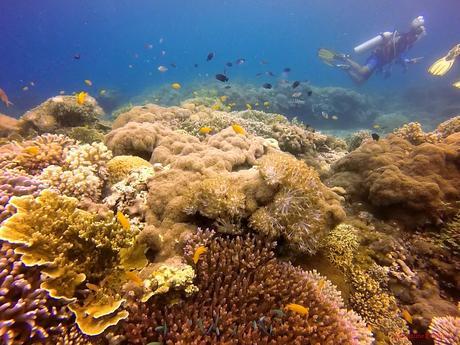
Scuba diving is one of our favorite activities. Yes, the activity allows us to ride boats, explore islands, bask in the tropical sun, escape the heat, and meet wonderful people. But more than that, it allows us to explore a colorful and sometimes dangerous world that is so bizarre that it almost defies imagination. It helps us realize just how tiny we are in this big, beautiful planet of ours.
Many of the most beautiful parts of this extraordinary world under the waves are in our country. And we will forever be indebted to The Bellevue Resort and its in-house provider Emerald Green Dive Center for giving us an opportunity to explore one of these pockets: Balicasag Island, which is a mile offshore of Panglao Island, Bohol.
We have taken note of the weather that week; most mornings were moderately sunny while it becomes cloudy durnig the afternoon. To take advantage of the fair weather in morning, Sweetie and I asked the hotel to book our dive at around 8 AM when the sun was still bright and unobscured by clouds.
We headed out to the hotel’s in-house dive shop Emerald Green Diving Center at 7:30 AM after our breakfast at Lamian Resturant. They also have a branch in our native island Cebu. Emerald Green Diving Center offers a comprehensive array of dive services, from DSD to certification to dive safaris.
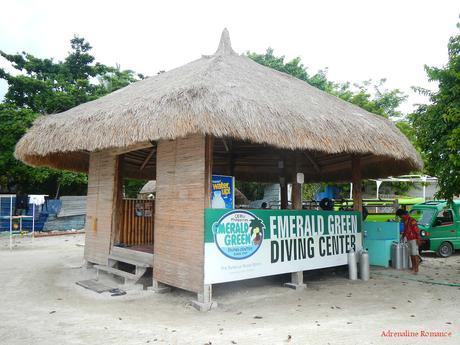
You won’t feel out of place in this warn dive center. Their visitor’s receiving area is simple, welcoming, and adorned with Filipino themed furnishing and decors. Staff members are warm and friendly.
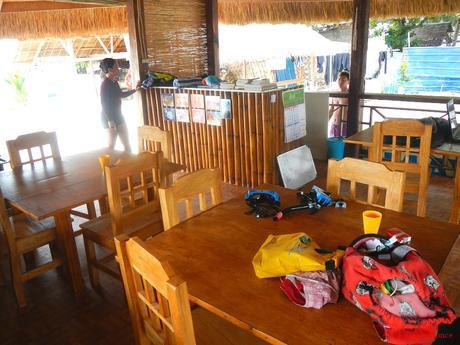
An equipment wash area is provided at the back of the resort. All their dive equipment are safely kept in a well-protected shed.
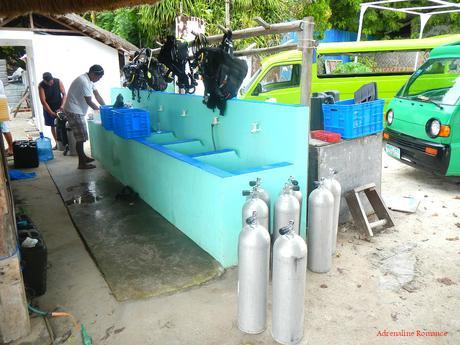
After filling out the necessary forms, meeting our divemaster John Galo, and fitting and assembling the equipment, we were ready to head off to our day’s dive sites. Check that out; we have the whole pump boat for us!
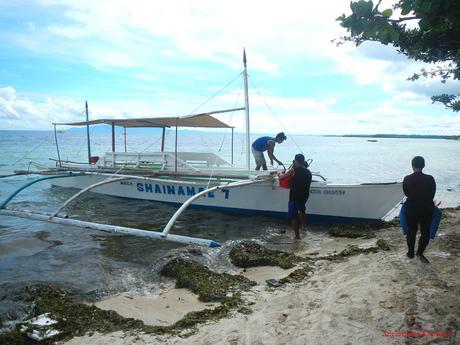
“Are you ready?” our dive master asked in which we replied an enthusiastic yes! So off we sailed to Balicasag Island, which was a 45-minute boat ride.
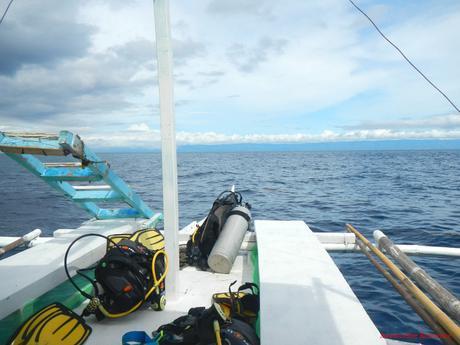
One of the interesting things we saw along the way was this large traditional fishing boat. John, being a former fisherman himself, explained that the long curved portrusions are poles for lamps and lines
Fisherfolk who man these boats stay off shore for days to harvest the bounty of the sea.
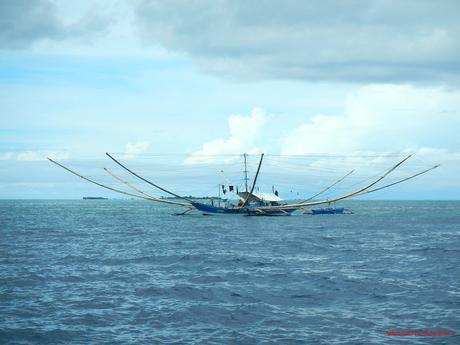
After almost an hour of riding through smooth waters, we arrived at Balicasag Island, which is known for its spectacular dive sites and sandy beaches. A fairly large islet, it is home to a small community of fishermen and resort workers. A lighthouse stands in the middle of the island.
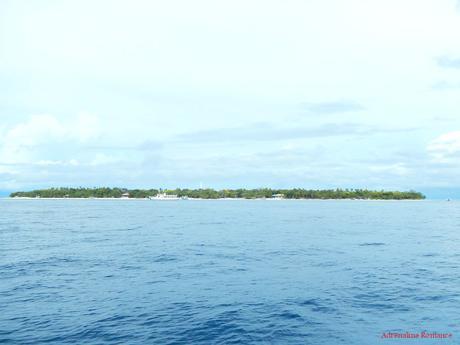
Tourists and scuba divers all over the world come to Balicasag Island to enjoy the rich marine life underneath the waves.
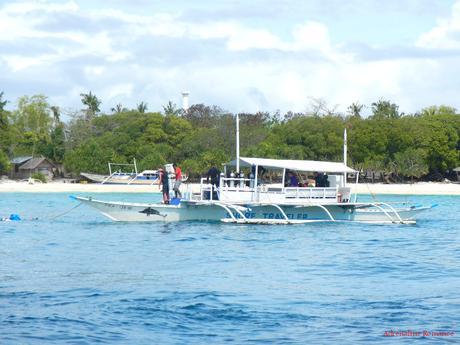
After choosing a spot and securing our boat to another one, John briefed us on the dive site and plan. This site, he said, had fairly strong currents, which we can simply drift on, saving lots of energy.
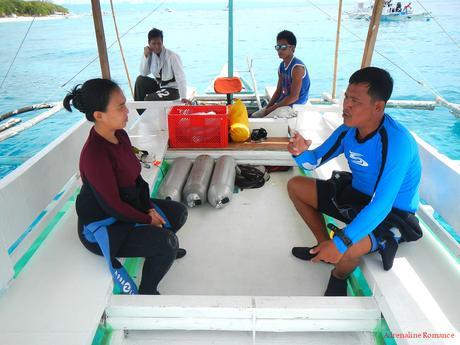
Black Forest
The first dive site we visited is Black Forest, named so because of the presence of various black corals in shallow depths. This is quite surprising as most species of black corals are found in deep water.
The entrance of Black Forest was an irony of its name. Instead of forests of corals, we found a vast bed of sand and sea grass.
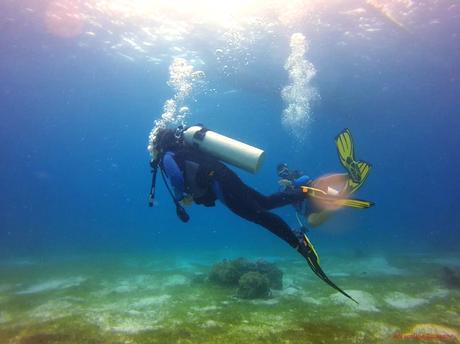
The abundance of green sea grass could only mean one thing—this is a feeding ground for sea turtles. And our guess was right. Just a few moments after we entered the water and established buoyancy, this magnificent green sea turtle came into view. This one is quite big, perhaps almost 5 feet long. Sadly, these beautiful, gentle animals are endangered species due to poaching, habitat loss, and global warming.
Green sea turtles dine on sea grass, kelp, and algae. We must have disturbed his mid-morning meal as he was still chewing his food while he swam away.
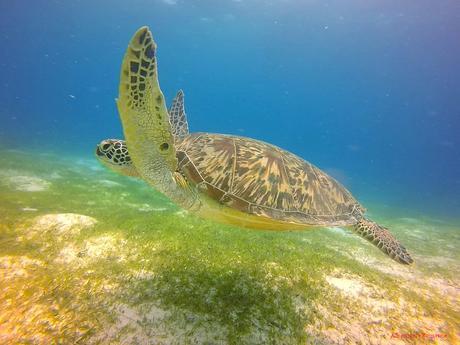
A pair of clownfish defended their home from three bubbling monsters who actually just came to admire them. Clownfish make their homes in anemones, and the two organisms share a symbiotic relationship with each other.
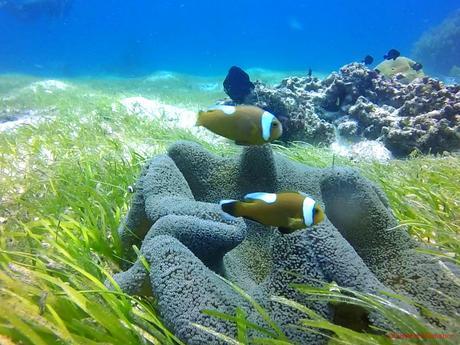
That’s a black coral. It got its name from its dark-colored exoskeleton. Underneath that hard shell however is its brightly colored living tissue.
Black corals are listed in the endangered species list, and hefty sanctions are placed upon those who harvest and kill these corals.
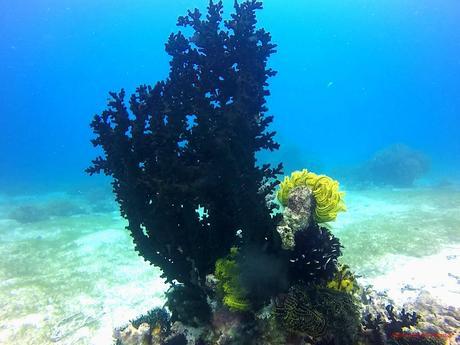
Large sea-born rocks serve as anchors for various corals, kelp, starfish, and other marine organisms.
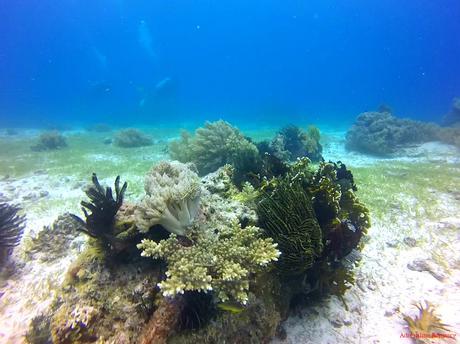
They may look like plants, but they’re actually sea anemones. Many fish and other organisms use them as homes and food.
Now, check out the direction of the anemone’s sway. The branches sway to the left because of the current. Black Forest medium to strong currents make it a favorite dive site for drift divers.
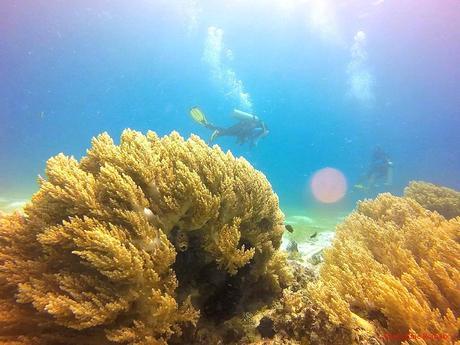
Just look at all that aquatic wildlife! Black Forest is considered by many divers to be one of the most vibrant and diverse sites in the world. In fact, in many instances, divers can encounter jacks, barracudas, eels, and more. I even encountered a large ill-tempered triggerfish which thankfully didn’t bite me!
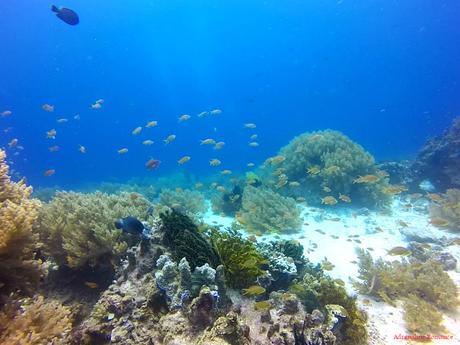
After touring the first section of Black Forest, our divemaster signaled us to start descending towards the dive site’s slope. As we went deeper, aquatic life became even more vibrant.
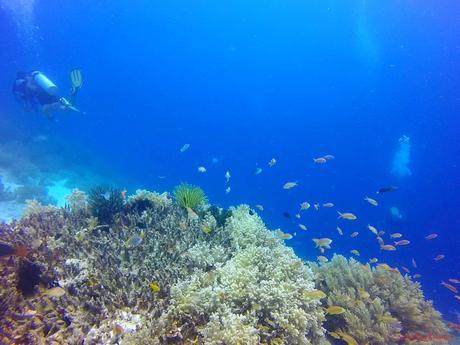
The Black Forest’s wall is actually a steep slope that extends to 40 meters, or around 130 feet. The slope is encrusted with hundreds of species of corals, plants, and fish. It’s Mother Nature’s extravaganza at her very best. Isn’t that beautiful?
There is a relatively strong current that flows across the slope. It’s really fun and relaxing to just ride the current.
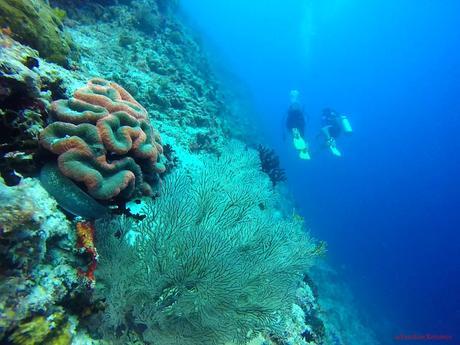
We saw plenty of black corals even at a depth of 50 to 60 feet. Its branches are very delicate, so it’s important not to touch them.
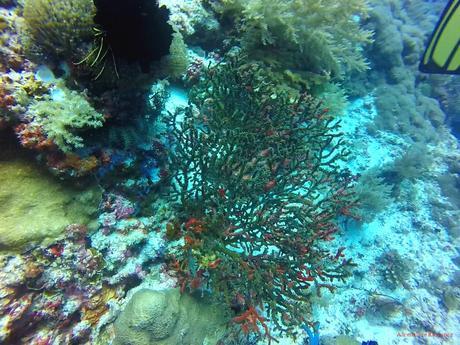
It was our first time to see such beautiful blue-corals. Corals such as these provide protection and shelter for fish and other marine organisms.
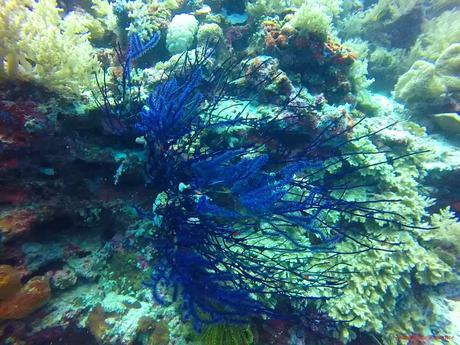
John stopped for a while and pointed out something in this coral. He later told us that he was pointing to a frogfish.
But where? A frogfish is a tyle of anglerfish that is covered with protrusions and other appendages. They can change color and shape, and some are even covered with algae. It has mastered the art of camouflage; we can’t even see it in the photo! It uses its superb camouflage ability to catch prey.
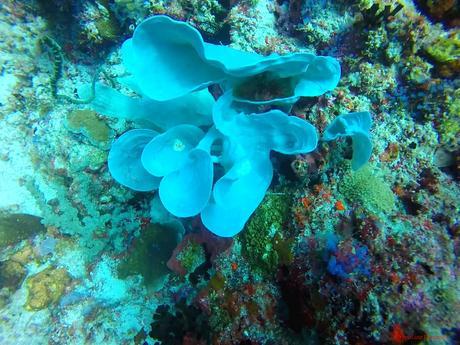
See that large ball of feathery appendages at the left of the photo? We thought it was a specie of coral or marine plant, but John said that these are actually some sort of starfish! Wow!
In the underwater world, you can see more life in 10 seconds than you do in 10 hours up in the mountain.
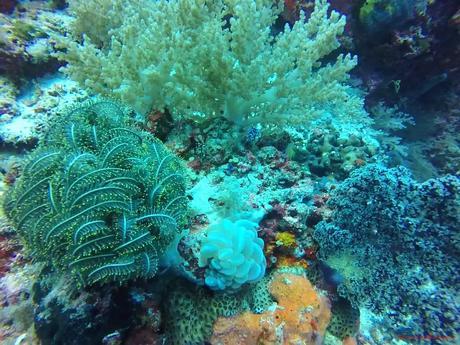
Describing the beauty of this colorful, strange, and largely undiscovered and often dangerous world hidden under the blue ocean is extremely difficult for me. Sometimes, in many of our dives, I find myself wishing that I was a creative poet rather than a prolific blogger.
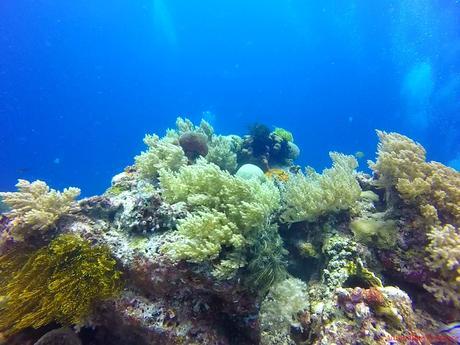
Even though it was a no-stop decompression dive, our divemaster did not take chances on safety. We had a 5-minute safety stop at around 18 feet to prevent nitrogen bubbles from forming in our bloodstream. Such phenomenon is called decompression sickness, and in extreme cases, it can lead to paralysis or even death.
While stopping at this depth (and while we were looking for some other interesting things), John launched a surface marker buoy to signal the boatmen above us that we are surfacing, and we’re getting ready to be picked up.
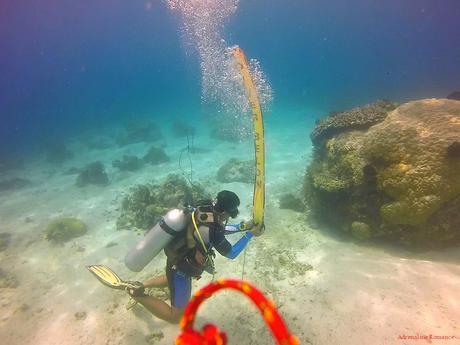
We boarded our pump boat, shed off our scuba equipment, and transferred to another dive site. We had a one-hour surface interval to allow the excess nitrogen in our bodies to dissipate.
While waiting for an hour, we chatted with our boatmen and divemaster about our adventures. It turned out that they were very interested in climbing and mountaineering as much as we were interested in diving!
Check out the aquamarine water and the white sand of Balicasag Island.
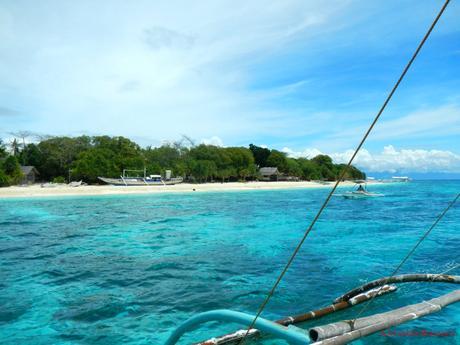
For those who do not wish to dive, they can simply don a mask, a snorkel, and a life jacket and simply head off into the marine sanctuary. Clearly marked buoys demarcate the snorkling area, and local guides ensure that visitors are safe while enjoying the rich marine wildlife.
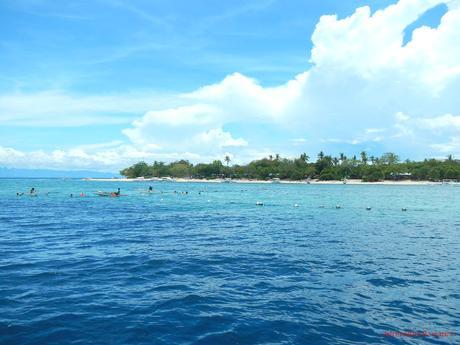
Balicasag Sanctuary
After an hour, we attached full air tanks, donned back our gear, and dived. Immediately below the boat is the deep abyss of the Balicasag Sanctuary, a protected area of the island. The snorkeling area is just beyond the left frame of the photo below.
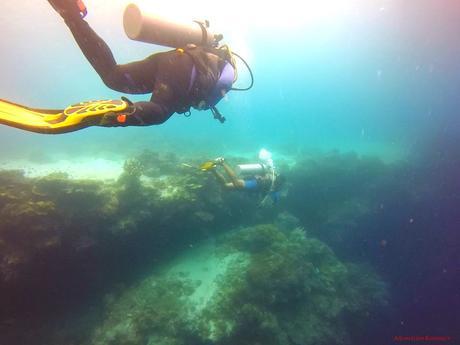
After establishing buoyancy, we started our descent. The sanctuary’s site begins immediately, and runs to more than 200 feet; this makes it a true wall dive. Without any current, this wall is very ideal for leisurely dives.
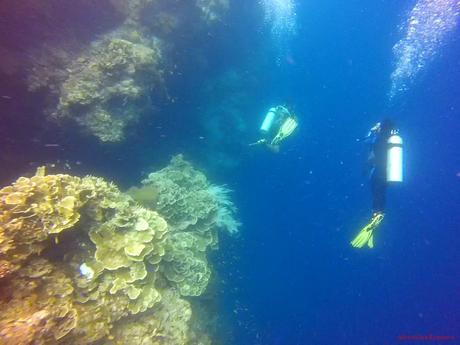
Look at that! Corals with ferns growing out of them?
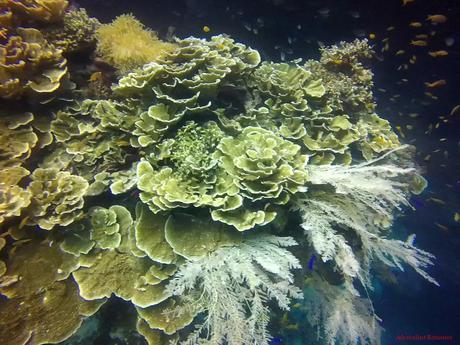
Just like on land, there are green plants underneath the sea. If you remember your biology in high school, the green color is caused by the presence of chlorophyll, which is critical in the process of photosynthesis.
This is actually really curious because at this depth, the sun’s light is considerably filtered. So how come this aquatic plant is still extremely verdant despite the lack of sunlight?
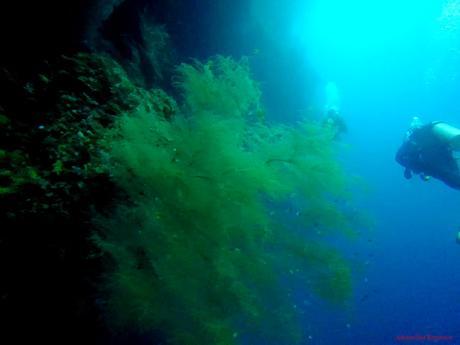
Here’s another strange plant life that looks more like feathery wisps than flora. Or is it really a plant? The sea is just so full of unknowns!
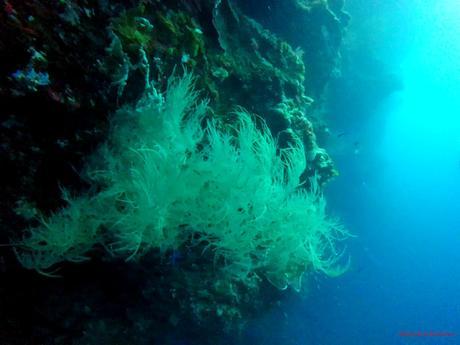
What in the name of all that is weird are these? They look like a colony of jelly balloons!

Abundant large and magnificent fan corals adorn the huge, dark rock wall.

Here’s a large fan of rare black coral protruding from the rock wall. We had to a little farther off the wall to avoid damaging the delicate corals and organisms that encrust it.
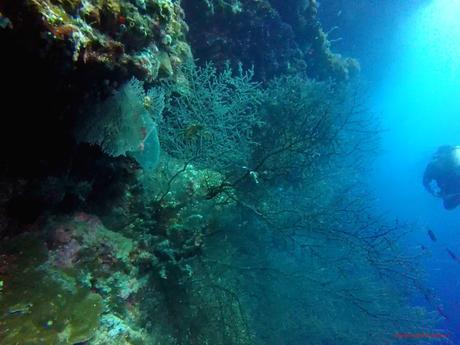
That deep blue looks really forbidding, isn’t it? Along the wall are geological depressions and caverns where experienced divers can explore.
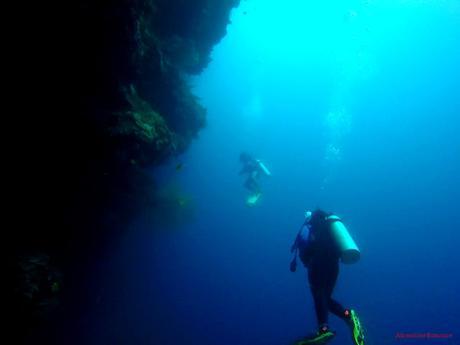
After more than half an hour of cruising along the wall, John signaled us to slow down and come forward. At first, we could not make out anything except for the telltale bubble trails of a group of scuba divers ahead of us. We knew that there was something interesting as everyone stopped at a certain place.
As we neared the group of divers, the dark, moving shadow loomed ahead of us. Upon closer inspection, we witnessed a spectacle of Mother Nature—a huge school of jackfish slowly swimming in circles in perfect coordination! The formation looks like a slow tornado of silvery fish!
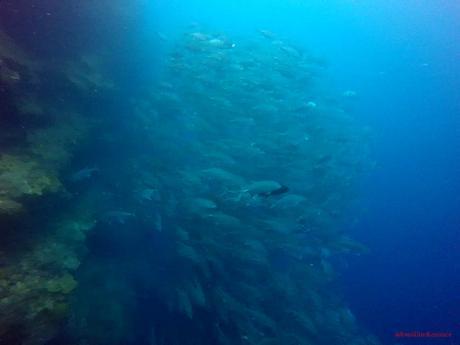
Every now and then, the tornado breaks up as the presence of divers, bubbles, and other organisms disturb their formation.
Jackfish are very common in tropical waters and come in many species.
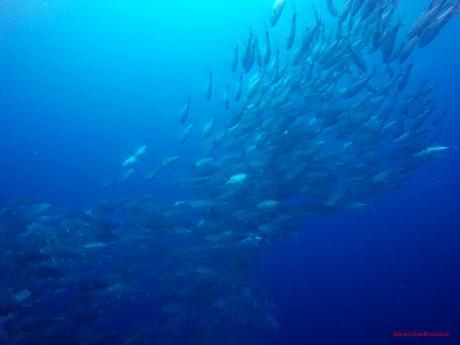
After admiring the immense school of jackfish, it was time to head to shallower water to check out Balicasag’s coral garden. To do that, we had to swim up this coral encrusted channel which leads directly to the garden at 30 feet.
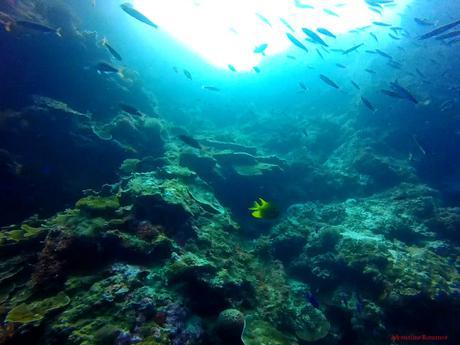
We couldn’t help explain a big wow through our regulators. The coral garden is simply magnificent beyond words. Corals of all kinds, colors, sizes, shapes, types, or species were seemingly congregated in this one spot.
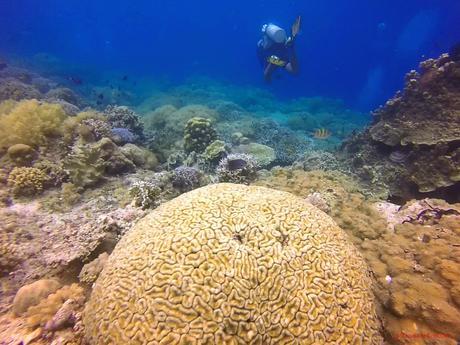
Come, I want to show you something, John motioned to us. What could it be? We’ve seen almost an infinite number of corals, and our mind was in beauty overload.
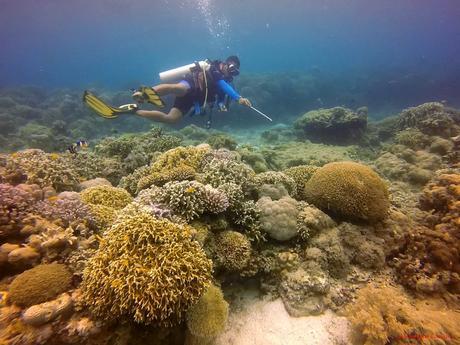
It turned out that this place is also a sanctuary of giant clams! With their colorful mantles pulsing slowly as they siphoned algae from the water, they were a delight to behold.
Giant clams are listed as vulnerable species in the International Union for Conservation of Nature (IUCN). These animals have been harvested for for food, jewelry, and decoration.
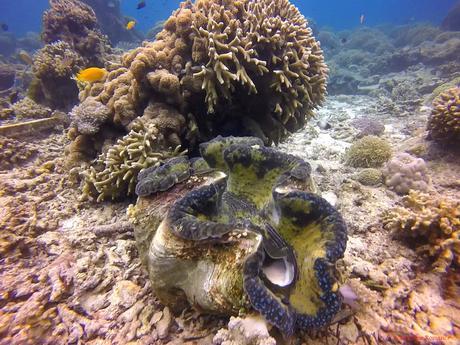
Artificial reefs have been transplanted here to promote coral growth. As you can see, the program is quite successful as the frames are now overgrown with hard corals.
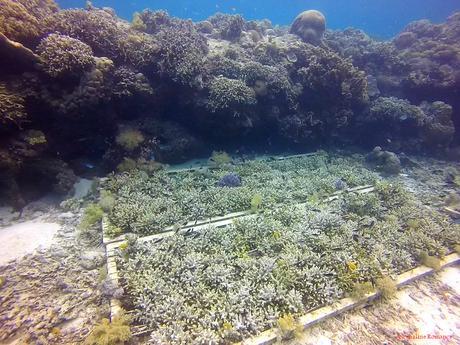
The Balicasag Sanctuary is so full of corals that we can hardly see the sand bed. This is an ideal standard of a healthy reef system.
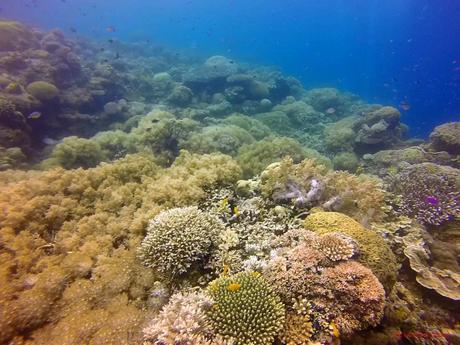
The Philippines is part of the Coral Triangle, a rough triangle-shaped geographical area that encompasses Indonesia, Malaysia, the Solomon Islands, Papa New Guinea, and Timor Leste. This expansive area is the termed as the Amazon of the sea and contains a staggering number of species of marine organisms. As of the present, the World Wide Fund for Nature (WWF) considers the Coral Triangle a top priority for marine conservation.
We have a natural treasure right in our backyard. It is very important that we, as individuals or nations, take measures to protect and conserve it.
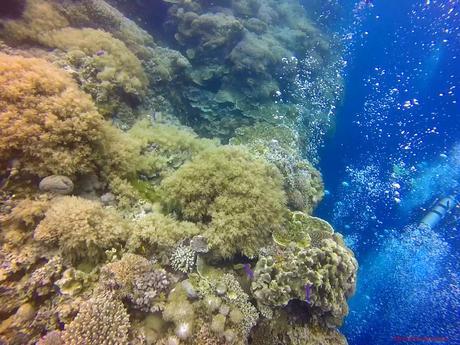
We finally surfaced at 1:00 PM, having seen the immense beauty of Balicasag Island. We sailed through the smooth mirror-like sea back to the resort where our lunch awaited us.
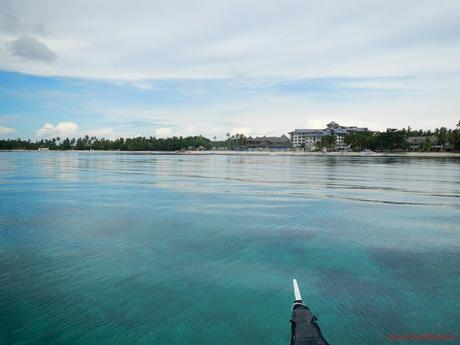
Mere photos cannot fully describe the beauty and motion of Balicasag Island’s underwater wonders. So we made this simple video for you so you’ll have an idea of just how beautiful these dive sites are
It has been said that the Philippines is a diver’s paradise. Now, we can confidently confirm that statement upon seeing the astounding beauty of Balicasag Island. We will surely come back for more as there are still two more dive sites that we want to explore.
Special Thanks
We would like to thank Mr. John Galo for being a wonderful, knowledgeable, and safety-conscious PADI-certified divemaster. He is one of the best divemasters we’ve ever been with.
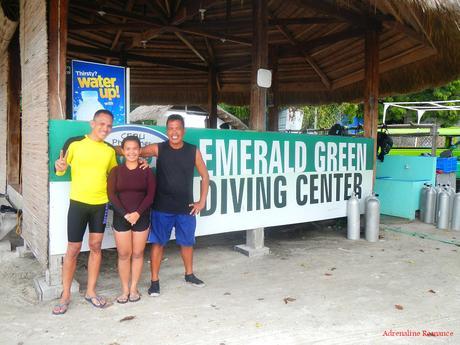
Thank you very much, Emerald Green Diving Center and The Bellevue Resort for this fantastic underwater adventure.
Tips
1. To get in touch with Emerald Green Dive Center, check out the contact details below.
- Cell Phone: 0939-919-4481
- Email: [email protected]
- Website: Emerald Green Dive Center
- Facebook page: Emerald Green Dive Center
The site and the Facebook page is in Japanese, so you might need to copy/paste the text in Google Translate for an English transcription.
You can also get in touch with The Bellevue Resort so that they can help you with your scuba dive tour.
2. Emerald Green Dive Center is The Bellevue Resort’s in-house dive shop. They also offer dive certification and licensing.
3. We didn’t set foot on the island itself, and The Bellevue Resort arranged everything for us. Thus, we are not sure how much are the necessary fees. Like all other adventures, it is recommended that you bring extra money to avoid unpleasant financial surprises.
4. Based on our research, food there is quite expensive. Thus, we suggest you bring your meals to save money. Of course, you will greatly help the island’s economy if you buy food there.
5. In general, it is best to dive in the morning when the sun is shining and at the right angle.
6. Medium to strong currents are present in certain areas in Balicasag Island. For snorkelers and swimmers, make sure you stay within the snorkeling area, which is marked by buoys. Never swim alone or beyond the limits of your ability. We recommend wearing a life jacket or bringing a floatation device with you at all times.
For divers, establish neutral buoyancy as soon as you can to avoid touching the seabed.
7. The dive shop will take care of your scuba equipment, so you don’t have to worry if you are not bringing your own set. Pack light but do bring the following:
- extra water ( at least 2 liters per person)
- rashguard and swimming shorts
- swimwear
- aqua shoes or slippers
- sunscreen
- hat
- sarong or towel
- snacks or packed meals
- personal medication and toiletries
- waterproof camera
- mask and snorkel (for snorkelers)
8. Be a safe and responsible diver. Always observe the Leave No Trace principle. Never touch, disturb, tease, or collect marine wildlife. Remember we are in an alien world that demands respect.

